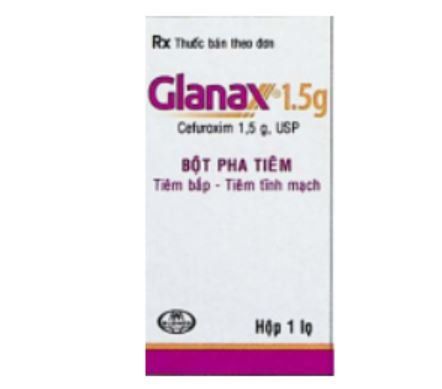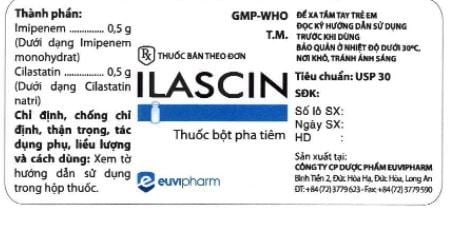This is an automatically translated article.
Zilvit has the main active ingredient Amikacin, a semi-synthetic antibiotic belonging to the Aminoglycoside group. Zilvit is indicated in the treatment of serious, life-threatening infections, especially blood infections suspected of being caused by Gram-negative bacilli.
1. What is Zilvit?
The main active ingredient of Zilvit is Amikacin, an aminoglycoside antibiotic. The mechanism of action of the drug is by binding to the 30S subunit of the bacterial ribosome and blocking bacterial protein synthesis. The activity of amikacin is mainly against aerobic Gram-negative bacilli. Zilvit has no activity against anaerobic bacteria and is limited to most Gram-positive bacteria.
2. What are the effects of Zilvit?
Zilvit is indicated in the treatment of serious/life-threatening infections, especially blood infections suspected of being caused by Gram-negative bacilli. Zilvit is often used in combination with Cephalosporins, penicillins and other antibiotics depending on the type of infection. In the treatment of endocarditis caused by S. faecalis or Streptococcus, Zilvit is usually combined with Ampicillin or Benzylpenicillin respectively. For the treatment of anaerobic bacteria, Zilvit can be combined with metronidazole or another anaerobic antibacterial agent.3. Dosage and usage of Zilvit
How to use:
Amikacin is administered intramuscularly or intravenously. For intravenous infusion, for adults, 500mg of Amikacin should be mixed into 100-200ml of infusion solution such as sodium chloride 0.9% or 5% dextrose, infused over 30-60 minutes. For children, the volume of infusion depends on the needs of the patient, but should be enough to be given in 1-2 hours in young children or 30-60 minutes in older children. Dosage:
The dose of Zilvit is calculated according to Amikacin and is the same when administered intramuscularly or intravenously. The usual dose of Zilvit in adults and older children with normal renal function is 15 mg/kg/day, divided into 2-3 equal doses, administered 8-12 hours apart. The maximum daily dose is 15 mg/kg or 1.5 g. The course of treatment with Zilvit should not last more than 7-10 days, and the total dose in adults should not exceed 15 g. However, Zilvit is now commonly used with a once-daily dosing regimen due to its equal effect and less toxicity. The recommended dose in this regimen is 15-20mg/kg, administered once a day. Patients with renal impairment: The dose of Zilvit must be adjusted according to the patient's renal function. It is recommended that serum Amikacin be measured and renal function carefully monitored during use. Patients with hepatic impairment: No dose adjustment of Zilvit is required in patients with hepatic impairment.
4. Side effects of Zilvit
Patients using Zilvit may experience the following side effects:
Nervous system: Neurotoxicity including muscle twitching, numbness, tingling on the skin, drug fever, headache, paresthesia , run. Ear: Auditory and vestibular toxicity. Renal: Nephrotoxicity, acute kidney injury, increased serum creatinine. Respiratory: Respiratory paralysis. Cardiovascular: Low blood pressure. Dermatology: Skin rash. Endocrine and metabolic: Albuminuria, hypokalemia. Gastrointestinal: Clostridium difficile diarrhea, nausea, vomiting. Genitourinary system: uremia, hematuria, oliguria, kidney toxicity. Hematology: Anemia, eosinophilia/leukopenia. Hypersensitivity: Drug reaction with eosinophilia and systemic symptoms. Musculoskeletal: Joint pain.
5. What are the precautions when using Zilvit?
Zilvit must be used with caution, especially for the elderly and young children because of the higher risk of nephrotoxicity. The patient's renal function should be closely monitored during administration. Avoid prolonged use of Zilvit or concomitant use of other drugs with nephrotoxicity, eg Bacitracin, Cisplatin, Amphotericin B, Polymyxin B, Colistin, Vancomycin, other Aminoglycoside antibiotics. Avoid concomitant use of Zilvit with strong diuretics such as ethacrynic acid, furosemide because the diuretic itself can be toxic to the ear and increase the toxicity of the antibiotic Amikacin. Serum concentrations should be measured when Zilvit is administered to patients with renal impairment. Zilvit should be used with caution in patients with muscle dysfunction, such as myasthenia gravis or Parkinson's disease. Because the drug has the potential to cause severe muscle weakness due to the effect on the neuromuscular connection. As with other antibiotics, prolonged use of Zilvit may induce the development of non-susceptible microorganisms. Neurotoxicity: Zilvit can cause neurotoxicity. Risk factors include pre-existing renal failure, concomitant use of neurotoxic drugs, advanced age, and dehydration. Ototoxicity: Ototoxicity will be proportional to the amount of drug given and the duration of treatment. Tinnitus or dizziness can be a sign of vestibular damage and impending irreversible damage to both ears. Discontinue treatment if there are signs of ototoxicity. Zilvit should be used with caution in patients with dizziness, tinnitus, or pre-existing hearing loss. Zilvit should be used with caution in patients with hypocalcaemia. Pregnancy: Amikacin can harm an unborn baby if it is taken by a pregnant woman. In general, Zilvit should not be used by pregnant women unless absolutely necessary. Lactation: Amikacin is excreted in breast milk. However, the drug is poorly absorbed orally. Therefore, the use of Zilvit in lactating women can be considered based on the risks and benefits of the drug. Store Zilvit medicine at a temperature below 40 degrees, preferably at 15-30 degrees, avoid freezing and direct light.
6. Drug interactions of Zilvit
Drug interactions can cause many clinical consequences such as changing the therapeutic effect and increasing the toxicity of the drug. To ensure that there are no drug interactions, patients should inform their healthcare provider about all medications and supplements they are taking. Here are some drug interactions to watch out for when using Zilvit:
Concurrent or sequential use of Zilvit with nephrotoxic or ototoxic agents (such as Vancomycin, Polymyxin B, Colistin, other aminoglycoside antibiotics) may increase the toxicity of the drug. Using Zilvit with neuromuscular blocking agents may increase the risk of neuromuscular block leading to respiratory paralysis. In addition, Amikacin may increase the effects of the muscle relaxant Cura and anesthetics. Amikacin may interact with a number of other drugs such as penicillins, furosemide, bumetanide and Indomethacin. Zilvit should not be mixed with other drugs, especially with beta-lactam antibiotics, as this may invalidate both drugs. The article has provided an overview of the antibiotic Zilvit. The information above is not a substitute for medical advice. If you have questions or need more information about your medication, you should contact your doctor or pharmacist.
Please dial HOTLINE for more information or register for an appointment HERE. Download MyVinmec app to make appointments faster and to manage your bookings easily.













